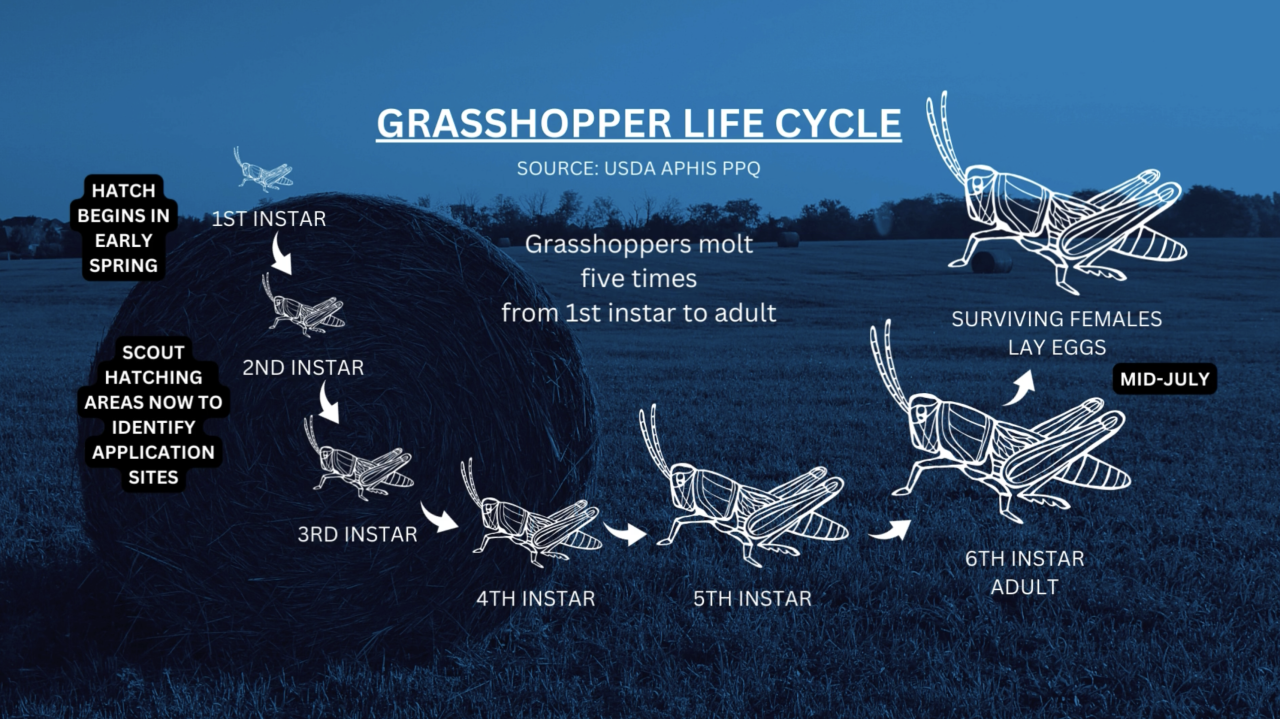TETON COUNTY — The Montana State University Extension Office in Teton County hosted a two-day seminar on Grasshopper Management last week. It welcomed the USDA Animal and Plant Health Inspection Service Plant Protection Quarantine State Plant Health Director Gary Adams to speak to Montana agriculture producers on how to stay ready for a dry year and a greater threat to grasshoppers.
“A cool wet spring is good, but it must be after they hatch. If it happens before they hatch it really has no impact on them,” explained Adams.
There are over 400 species of grasshoppers in the Western United States and only a select few creating an economical impact to human industry in Montana. The Lesser Migratory and Clear Winged Grasshopper are most prominently found as “pests” in farmland across The Treasure State. While two dozen of them also considered pest species. There are a few species that are beneficial because they eat undesirable plants.
- Obituary: Bonnie Bonahoom Peretti
- 'Fire Within' awards for women
- WATCH: elephant runs loose in Butte
- MVD Express now open in Great Falls
“Those are the two major species there are others that are major crop species that could be different than grasshoppers that eat grasses and grasshoppers that eat forage.” Adams said. “There are grasshoppers that eat everything and those are the latter two. They build up in these big populations that can be devastating.”
Grasshoppers and Mormon Crickets are native to Montana. Mormon Crickets are present but have not reached outbreak-level populations like other states around the country.
While there are over 400 species of grasshoppers in the Western United States the general life cycle of the species is essentially, universal across the board.
The free seminar in Teton County – isn’t in the hot spot for the worse projected areas of grasshopper populations. Adams told MTN, his goal is to get agriculture producers prepared to check their land now, rather than waiting for a population to get out of hand.
“Last year we did have some hot spots that were sprayed, field edges, fence lines,” explained Joel Farkell, Certified Crop Consultant.
Farkell works with farmers and ranchers to determine what suppression plan is right to combat grasshoppers. It’s important to note the USDA and Farkell aren’t looking to eradicate grasshoppers entirely – it promotes suppression methods through USDA sanctioned programs and finding the right plan of action for the individual operation.

Those sanctioned programs are offered through the USDA Rangeland Grasshopper Mormon Cricket Suppression Program – if you’re a producer and have questions regarding the population of nymphs on your property, the state APHIS Office and your local extension agent are of help to you.
According to the USDA Animal and Plant Health Inspection Service’s data, federal agencies own or manage approximately 43 percent of U.S. rangeland. It’s spread across numerous agencies and those lands are eligible for cooperative grasshopper or Mormon Cricket suppression methods to prevent wider outbreaks of a species. APHIS shares the costs of providing suppression treatments on rangelands per federal law of the Plant Protection Act.
On Tribal Trust rangelands, APHIS pays 100 percent of the treatment. On State lands, APHIS provides 50 percent of the treatment costs, and the State provides the remaining funds. When it comes to Private lands, APHIS covers 33 percent of the treatment costs, with the State and/or private landowner responsible for the remainder. Cost shares are only available if APHIS conducts the treatments.
Farkell said, “We really work with our customers on identifying the numbers and first off are they at an economical threshold of where a management option would be economical to their operation.”
In March 2024, MTN reported on the Montana Stockgrowers Association sending a letter to Congressman Ryan Zinke (R-Montana) requesting more funding for grasshopper suppression. Sen. Jon Tester (D-Montana) reported in a press release Congress passed a mini-bus funding package to keep the government afloat. In that package, it offered $30.5 million for Packers and Stockyards (P&S) enforcement, $3.5 million for Western Precision Livestock Management, with the state of Montana receiving an additional $1 million to invest in the Rangeland Grasshopper Suppression Program and increased funding for the Barley Pest Initiative.
“Funding can come from a variety of places and from an agriculture standpoint it can cover a variety of industries in it.” Farkell said. “It’s good to always look out from something that can help improve your bottom line.”

While grasshoppers aren’t forecasted along the Rocky Mountain Front as poorly as eastern Montana – the Adams and Farkell are asking growers and livestock producers to check their land now. Adams told MTN, if you notice a full-grown grasshopper right now – don’t panic. He says some species hatch over the winter but don’t have the same effect on crops or forage land as the others that hatch in the spring. Right now, hatched grasshoppers will be approximately the size of a grain of rice.
"Get out there. Get on the ground," added Adams. "Identify the sizes of grasshoppers. The early hatches are about the size of a grain of rice… If they wait until they’re old and flying and the opportunities are diminished to manage that population at that point.”
If you notice a large population of the “grain of rice” sized hoppers on your property you can contact the State Plant Health Director’s Office in Billings at (406) 657-6282 or in Helena at (406) 449-5210.
For a full list of contacts for the county based MSU Extension Offices, click here.




